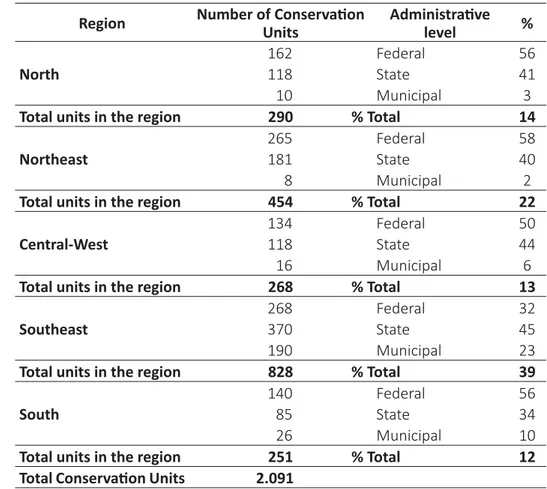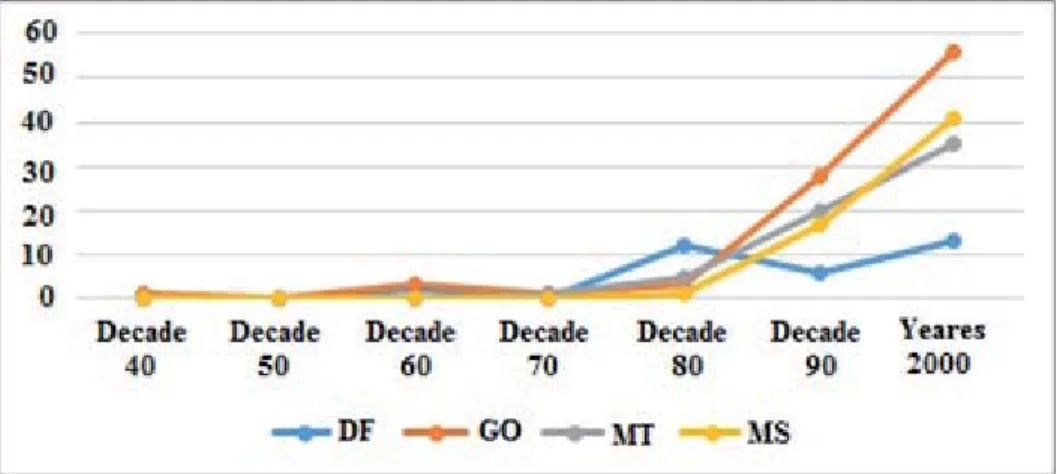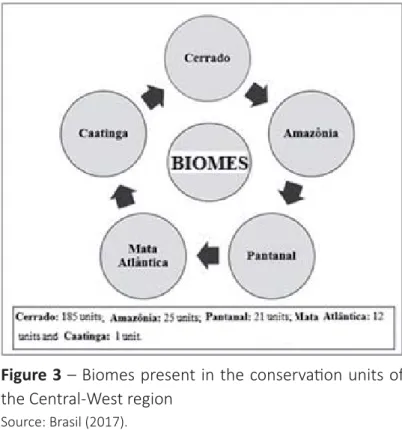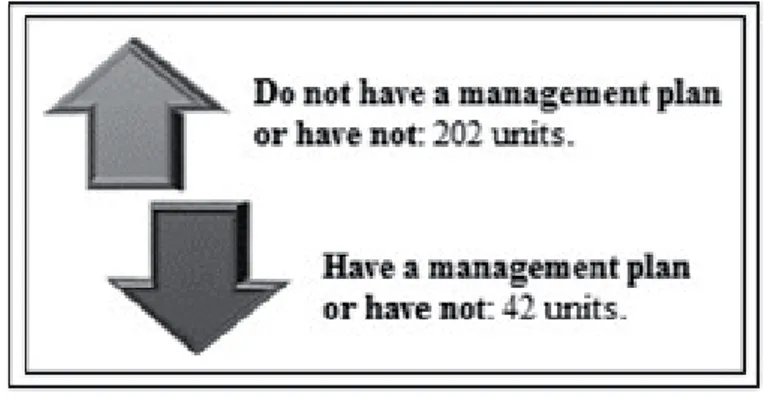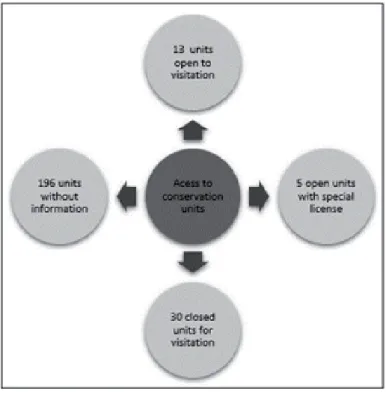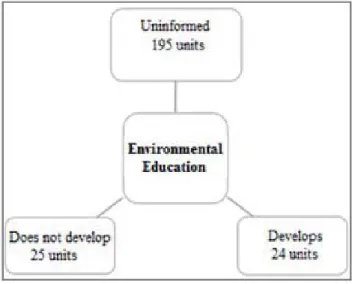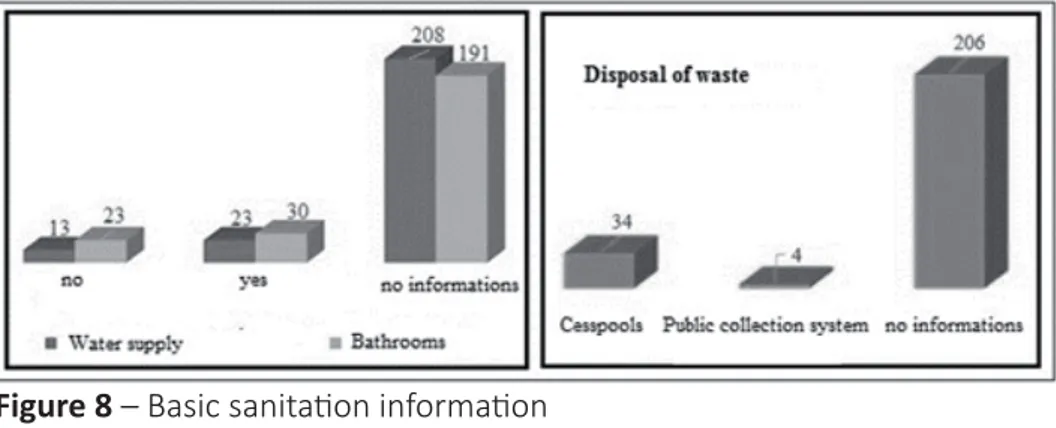CharacterizaƟ on of conservaƟ on units of the Central-West
region of Brazil
Caracterização das unidades de conservação da região
Centro-Oeste brasileira
Caracterización de las unidades de conservación de la región
Centro-Oeste brasileña
Maycon Jorge Ulisses Saraia Farinha1 Luciana Virginia Mario Bernardo2 Vanderson Aparecido de Souza3 Luciana Ferreira da Silva4
1 Mestre em Agronegócios, Licenciado e Bacharel em Geografi a, ambos
pela Universidade Federal da Grande Dourados (UFGD). E-mail: maycondds@hotmail.com
2 Doutoranda em Desenvolvimento Regional e Agronegócios pela
Unioeste, Mestre em Agronegócios e Bacharel em Ciências Contábeis, ambos pela UFGD. Universidade do Oeste do Paraná (Unioeste).
E-mail: lucianamario@yahoo.com.br
3 Mestrando em Agronegócios e bacharel em Ciências Contábeis pela UFGD.
E-mail: vanderaparecido@hotmail.com
4 Professora Doutora do Programa de Mestrado em Agronegócios da UFGD.
Abstract: The objec ve of this research is to characterize the exis ng conserva on units
in the Central-West region of Brazil, considering some aspects of the Presiden al Decree No. 4.340/2002, which provides the necessary guidelines for the crea on of conserva on units. The choice of this region is due to its diversity of biomes. The deduc ve method was used for the elabora on of the research, star ng with informa on about the country and sequen ally about the chosen region. Even though there is a na onal registry of conserva on units, there is a lack of informa on on these areas, because it is not fi lled in completely.
Keywords: environmental conserva on; crea on of conserva on units; environment. Resumo: O obje vo da pesquisa é caracterizar as unidades de conservação ambiental
existentes na região Centro-Oeste do Brasil considerando alguns aspectos presentes no Decreto Presidencial n. 4.340/2002, que é o documento legal que explicita as caracterís cas necessárias para a criação de unidades de conservação. Essa região foi neste estudo escolhida pela sua diversidade de biomas. Foi u lizado um método dedu vo para a confecção da imagem da área da pesquisa, para isso par ndo de informações para o país e, sequencialmente, para a região escolhida. Observou-se que, mesmo havendo um cadastro nacional de unidades de conservação, existe carência de informações sobre essas áreas, pois tal cadastro, na maioria das vezes, é preenchido não por completo.
Palavras-chave: conservação ambiental; criação de unidades de conservação; meio
ambiente.
Resumen: El obje vo de la inves gación es caracterizar las unidades de conservación
ambiental existentes en la región Centro-Oeste de Brasil considerando algunos aspectos presentes en el Decreto Presidencial n. 4.340 / 2002, que es el documento legal que explicita las caracterís cas necesarias para la creación de unidades de conservación de conservación. Esta región fue en este estudio escogida por su diversidad de biomas. Se u lizó un método deduc vo para la confección de la imagen del área de la inves gación, para ello par endo de informaciones para el país y, secuencialmente, para la región elegida. Se observó que, aun habiendo un registro nacional de unidades de conservación, existe carencia de informaciones sobre esas áreas, pues tal registro, la mayoría de las veces, se rellenan no por completo.
Palabras clave: conservación ambiental; creación de unidades de conservación; medio
1 INTRODUCTION
In Brazil, the Law no. 6.938, published in 1981, instituted the Na onal Environmental Policy. Its inten on was to create measures for the preserva on of the environment, in order to integrate it with the social and economic aspects inherent to the society. In addi on, the Law establishes the Na onal Environmental System and the Na onal Environmental Council, ac ng in a complementary way to regulate the guidelines of environmental licensing performed by states and municipali es. From this legisla on, the country changes its perspec ve from preserving the landscape for its scenic beauty to the conserva on of the ecosystem services off ered by nature.
The importance of environmental preserva on is reinforced, as it is inserted in the Ar cle 225 of the Federal Cons tu on the security of the right of all Brazilians to have a balanced environment. Subsequently, Law number 9.985/2000 is enacted to establish the Na onal System of Nature Conserva on Units (SNUC [BRASIL, 2006). In the SNUC are defi ned criteria and standards for the crea on, execu on and management of conserva on units. The aim of SNUC is to guarantee a be er quality of life for the local popula on and the region, from the crea on of conserva on units. Therefore, reducing the nega ve externali es of neighboring proper es to the conserva on unit.
The profiles of conservation units determine that these are of full protec on (indirect use of natural resources) and sustainable use (sustainable use of natural resources). The full protec on units are divided into fi ve categories of preserva on and the sustainable use units in seven. In these categories the objec ves of preserva on and the characteris cs of each unit are defi ned. In the case of sustainable use units, it allows private preserva on in one of its categories, all the others are public conserva on areas. Therefore, considering the environmental services provided by these areas and the importance of environmental conserva on, so that the Brazilian biodiversity can remain, the objec ve of the research is to characterize the conserva on units in the Central-West region of Brazil. The choice of this region is due to its diversity of biomes.
2 MATERIAL AND METHODS
In order to carry out the survey and characterize the existing conserva on units in the Central-West region of Brazil, the deduc ve method was used to approach the problem, which allows star ng from general ques ons to obtain answers for specifi c ques ons, using descrip ve and bibliographic research. The number of these units in Brazil and by Brazilian regions were iden fi ed, specifying the number of areas, the percentage of the area of the protected biome and square kilometers preserved by categories. A erwards, the descrip on in the Decree No. 4.340/2002 was used, which refers to the indica ons that must be made at the me of the crea on of conserva on units, to characterize them in rela on to: “management category, area of the unit and the ins tu on responsible for its administra on” (BRASIL, 2002, p. 1).
There was also a need to describe the conserva on units regarding the biomes in which they are inserted, educa onal ac vi es executed in the area, presence of residents of tradi onal, indigenous or quilombola popula on, availability of electricity, water supply, restroom, waste disposal and popular visita on. The data were collected on the website of the Ministry of Environment in the Na onal Register of Conserva on Units and organized by state of the Central-West region, in May of the respec ve year.
3 RESULTS AND DISCUSSION
3.1 CharacterizaƟ on of conservaƟ on units in Brazil
Table 1, shows the number of conservation units registered in Brazil. It also informs the number of these units by Brazilian region and the administra ve level. The Southeast region has the largest number of protected areas created up to the me of the survey. It is also observed that only the Southeast region has a number of units created at the state level, higher than the number of protected areas created at the federal level. This characteris c may be related to the state public policies for crea on incen ve. From the total percentage, a decreasing ranking of the regions with the respec ve totals of the conserva on units, being: Southeast, Northeast, North, Central-West and South.
Table 1 – Conserva on units by brazilian region
Region Number of ConservaƟ on Units AdministraƟ ve level % North
162 Federal 56
118 State 41
10 Municipal 3
Total units in the region 290 % Total 14
Northeast
265 Federal 58
181 State 40
8 Municipal 2
Total units in the region 454 % Total 22
Central-West
134 Federal 50
118 State 44
16 Municipal 6
Total units in the region 268 % Total 13
Southeast
268 Federal 32
370 State 45
190 Municipal 23
Total units in the region 828 % Total 39
South
140 Federal 56
85 State 34
26 Municipal 10
Total units in the region 251 % Total 12
Total ConservaƟ on Units 2.091
Source: Brasil (2017).
The conserva on units created in the diff erent Brazilian regions, as Laurance, Sayer and Cassman (2014) indicated allow the preserva on of the ecosystem services of the diff erent biomes that form Brazil. These territorial por ons of conserved area provide the guarantee of the right established in the Federal Cons tu on for Brazilians in rela on to the environment (BRASIL, 1988).
Table 2 establishes the rela onship between the type, number of conserva on units and biome. Regarding the type of conserva on unit, there is a trend towards the crea on of more units in sustainable use. It is jus fi ed, based on the notes made by Ayach, Bacani and Silva (2014), on the improvement of Brazilian legisla on, in what refers to the conserva on
of environmental areas. Regarding the preserva on of biomes, the Atlan c Forest has the largest number of conserva on units, however, the area is propor onal to 10% of the total area of the biome in Brazil. It should be pointed out that in the Brazilian Amazon biome, even not having the largest number of conserva on units, it has the highest percentage of conserved area.
Table 2 – Number of conserva on units by type and biome
Kind
Biomes Brazilian
Amazon CaaƟ nga Cerrado
AtlanƟ c
Forest Pampa Pantanal
N1 %2 N1 %2 N1 %2 N1 %2 N1 %2 N1 %2
PI3 82 10,2 39 1,2 120 3,1 376 2,5 13 0,4 7 2,9
US4 247 17,5 125 6,5 264 5,5 759 7,5 13 2,4 17 1,6
Total 329 27,7 164 7,7 384 8,6 1.135 10 26 2,8 24 4,5
1- Number of Conserva on Units; 2- Percentage of the conserved area in on to the total area of the biome; 3- Full Protec on; 4- Sustainable Use
Source: Brasil (2017).
From Table 2 it is possible to observe that the conserva on units are located in the diff erent biomes that exist in Brazil, but in a diff erent way, both for the number of units created and in rela on to the percentage of protec on of the areas of the biomes. Sukhdev et al. (2010) considered that the conserva on of areas assists in the maintenance of biodiversity and in the sharing of informa on regarding the intrinsic culture of space.
Table 3 provides informa on about conserva on categories, biome and preserved area. It can be seen that there are no protected areas created for all categories in all biomes. The reason for this non-existence may be related to the considera ons of Milaré (2011) on the crea on of a conserva on unit, following criteria established by the SNUC, among which the natural relevance aspect should be iden fi ed in the area and be related to the specifi c category of unit. In this context, two par cular situa ons stand out, namely the Pantanal biome, which has four categories of conserva on units, to which 36% of the preserved area is managed by private ini a ve and the Fauna Reserve category does not have any preserved area, among the biomes.
For Brasil (2000) the Private Natural Heritage Reserve is cons tuted from the characteris c of the owner in conserving the biodiversity in their property or part of it. The crea on of the conserva on unit in this case comes from the owner’s desire to preserve the environmental characteris cs of the space. The Fauna Reserve, which is a gap in conserva on units, is created by the government’s decision to invest in technical-scien fi c studies that allow the sustainable management of wildlife resources. From the maintenance of na ve species of resident or migratory animals. In the la er case, there is a need for greater interest by public managers in the conserva on of Brazilian fauna, so that there may be resources to invest in future research in the country.
Table 3 – Conserva on area by category and biome
Category Biome / Area in square kilometers
Integral ProtecƟ on Brazilian Amazon CaaƟ nga Cerrado AtlanƟ c Forest Pampa Pantanal
Ecological Sta on 107.638 1.389 11.435 1.479 105 116 Natural Monument 0 594 314 509 0 3 Parks 268.724 7.601 48.692 23.260 392 4.285 Wildlife Refuge 64 395 2.460 737 26 0 Biological Reserve 52.856 70 81 2.453 105 0 Sustainable Use Forest 312.675 542 557 356 0 0 Extrac ve reserve 137.749 19 883 712 0 0 Sustainable Development Reserve 110.789 84 686 528 0 0 Wildlife Reserve 0 0 0 0 0 0 Environmental Protec on area 173.643 52.294 108.504 80.960 4.214 0 Area of Relevant Ecological Interest 446 198 87 271 14 0 Private Natural Heritage Reserves 466 477 1.069 1.035 4 2.488 Total conservaƟ on area 1.165.051 63.673 174.769 112.300 4.861 6.891 Source: Brasil (2017).
The lack of conserva on units in all biomes could be detrimental to biodiversity, once each category of conserva on unit was established based on the valoriza on of na onal characteris cs. Souza (2014) reinforces the importance of the existence of each of the conserva on units, evidencing that the decision-making process to establish the guidelines of SNUC, demanded several discussions. However, even if they are based on interna onal models, the categories of the protected areas were established based on the socio-environmental peculiari es of the country. Each of the categories are individual and irreplaceable.
3.2 CharacterizaƟ on of conservaƟ on units in the Central-West region
Table 4 indicates the number of conserva on units by category, of the states that cons tutes the Central-West Region. In rela on to full protec on, the State of Mato Grosso has the largest number of units (44% of the total), of which are concentrated in the park category, approximately 69% of the conserva on units. Regarding sustainable use, the number of conserva on units in the State of Goiás is exponen al (44% of the total). The category with the greatest contribu on to this number is the private natural heritage reserves, with a concentra on of 75% of the units considered to be of sustainable use. It should be highlighted that, with the excep on of the Federal District, the characteriza on of the number of protected areas indicates that the park and private reserve categories of natural heritage are those that stand out in rela on to the number of units. The infl uence of public and private agents on the conserva on of natural resources in the Central-West Region is percep ble.
Tabela 4 – Conserva on units per state of the Central-West region of Brazil
Category Federal District Goiás GrossoMato Mato Grosso do Sul
Full ProtecƟ on Ecological Sta on 2 0 7 0 Natural Monument 1 0 1 3 Parks 1 15 22 13 Wildlife Refuge 0 0 2 0 Biological Reserve 4 0 0 1 Total 8 15 32 17 Sustainable Use Forest 1 4 0 0 Extrac ve reserve 0 2 1 0 Sustainable Development Reserve 0 0 0 0 Wildlife Reserve 0 0 0 0
Environmental Protec on area 6 12 8 5
Area of Relevant Ecological
Interest 13 1 0 0
Private Natural Heritage
Reserve 5 58 20 37
Total 25 77 29 42
Source: Brasil (2017).
For Andrade and Iadanza (2016) the crea on of conserva on units is complex due to diff erent interests in the context, which requires the convic on of society about the need for this prac ce in order to have socio-environmental sustainability. This process of conserva on, for Andrade and Silva (2003) began in 1934 in the State of São Paulo, from Protec ve Forests, to which the scenic beauty of the landscape was valued. From this milestone, the legisla ons have been amended and the approach is expanded for the conserva on of biodiversity.
Figure 1 shows the number of protected areas organized by hectare scale for the Central-West Region. It is observed that there are two extremes of numbers; the range from 1 to 100 hectares (61 units) and greater than 1000 hectares (122 units). These are considered to be the smallest and largest areas of units. Thus, it is indicated that the conserva on units can
have diff erent sizes, and this is not a determining factor for their crea on. It is noteworthy that there are conserva on units in this region, with no informa on on the size of the area.
Figure 1 – Areas of the conserva on units of the Central-West Region
Source: Brasil (2017).
There is no minimum or maximum size to determine the crea on of a conserva on unit, which may be smaller than one hectare. However, the environmental characteris cs in the area are indica ve for the decision-making for the crea on of the units. The technical inspec on report, especially for private units, establishes if the area indicated for the crea on of the conserva on unit has a ributes for the recogni on of the same (BRASIL, 2012).
It is observed in Figure 2 that since the 1980s there has been a growth in the crea on of conserva on units in the states. In the case of the Federal District, there was a decline in the 1990s, but there was again a growth in 2000.
Figure 2 – Crea on of conserva on units in the brazilian Central-West region
Source: Brasil (2017).
For Miller (1997) the human need in rela on to natural resources is the jus fi ca on for the crea on and maintenance of protected areas. Conserving these spaces implies maintaining their cultural and historical characteris cs. Vallejo (2002) understands these conserva on units as territories. Studies developed in diff erent areas of knowledge about the environment, help in the crea on of these units by indica ng the importance of conserva on for the con nuity of the existence of diff erent natural resources.
In rela on to the biomes, in which the conserva on units are in, there is a range of all biomes present in the Central-West region of the country, to a greater or lesser extent: all the conserva on units of the Federal District conserve the Cerrado biome; Goiás 99% of the conserva on units conserve the Cerrado biome and 1% Caa nga; Mato Grosso 46% the Cerrado biome, 42% the Brazilian Amazon biome and 12% the Pantanal biome and in Mato Grosso do Sul 56% of the units conserve the Cerrado biome, 24% the Pantanal biome and 20% the Atlan c forest biome.
Figure 3 – Biomes present in the conserva on units of
the Central-West region
Source: Brasil (2017).
The conserva on units created in the Central-West Region of Brazil contribute to the responsibility that the country has, according to Rylands and Brandon (2005), in maintaining the biodiversity iden fi ed in its territory. Considering the scope of the number of biomes conserved with these units and consequently their biodiversity in each case. Mainly, as regards the maintenance of environmental areas in the Cerrado biome, which is in danger.
The management plan (Figure 4) is important for the management process of protected areas. The document is created from the objec ves of the unit. It is described, in the management plan, from the characteris cs of the conserva on units to the way the ac vi es in the units are developed. Most of the conserva on units state that they do not have a management plan, but for Brasil (2000) all units must have their own plan, within fi ve years a er the unit is created. Considering the crea on year of the conserva on units in the na onal system, most of these units should have this document elaborated.
Figure 4 – Informa on on the management plan
Source: Prepared from the Brasil (2017).
Among the benefits presented by the conservation units is the possibility of access to visita on and in some cases the development of other ac vi es in the areas. This characteris c can help in the development of environmental educa on, which contributes to the ci zen training of individuals to broaden environmental conserva on prac ces. It is observed that the units located in the Central-West Region, have li le informa on about the accessibility of visita on (196 without informa on). In addi on, the number of conserva on units without access to visita on (30 units) is greater than the result of the addi on (18 units) between open units or with special permit for visita on (Figure 5).
Figure 5 – Visi ng the conserva on units
Source: Brasil (2017).
The visita on of the conserva on units can help with the achievement of the objec ves of each unit category, described by Brasil (2000). It is believed that individuals who have access to these areas can receive instruc ons that help in understanding the importance of crea ng and maintaining these units to reduce the environmental impacts that diff erent human ac vi es produce in rela on to the environment. For Barnosky et al. (2011) and Pimm et al. (2014) the rela onship between individuals and the environment can result in increased biodiversity loss if there is no care to reduce the impacts that can be caused.
Regarding the exis ng prac ces of Environmental Educa on in these spaces, the available informa on indicates that of the total conserva on areas, 24 units developed activities related to this education format. However, most of these spaces (195 units) do not provide informa on about these prac ces and 24 units do not develop them.
Figure 6 – Environmental educa on in conserva on
units in the Central-West region
Source: Brasil (2017).
Environmental Educa on Prac ces may contribute to Brasil (1988) inten on in rela on to the crea on of conserva on units so that future genera ons can have access to the environmental characteris cs in Brazil, that is, to all the biodiversity exis ng in the country, therefore, conveys informa on to educate people about the need to preserve the environment. Machado (2012) points out that requirements are made for the opening of the visita on in conserva on units, based on measures of protec on and safety for visitors who contemplate the maintenance and recommenda ons necessary to this prac ce, without causing environmental impacts.
In rela on to the infrastructure in these units considering electric energy (Figure 7), a high number of units did not provide informa on. Those who disclose informa on, network energy is predominant (39 units), the renewable energy system (5 units). Considering that the purpose of these units is to preserve the nature or other tangent regarding this situa on, it is advisable to invest in renewable energy systems in these spaces.
Figure 7 – Informa on on electric power
Source: Brasil (2017).
In Figure 8, regarding basic sanita on, there is a lack of informa on about the units of conserva on. There is water supply in 23 units and restrooms in 30 units. The waste disposal is in cesspools in 34 units.
Figure 8 – Basic sanita on informa on
Source: Prepared from the Brasil (2017).
The characteriza on of the structural informa on of conserva on units is important to indicate the need for improvements if there is investment in environmental educa on within these areas. In addi on, seven units were iden fi ed with residents of tradi onal, indigenous or quilombola popula on.
Other 111 units do not disclose this informa on. Thus, in the units where this popula on lives, infrastructure can be a measure of disease preven on for them. Another important aspect for conserva on units is the agencies responsible for enabling their crea ons and supervising the units. In Chart 1 it is possible to iden fy the federal, state and municipal performance in these organs, in diff erent amounts per state.
Federal District Goiás Mato Grosso Mato Grosso do Sul
Ins tuto Chico Mendes de Con-servação da Bio-diversidade; Ins tuto do Meio Ambiente e dos Recursos Hídricos do Dis-trito Federal.
Ins tuto Chico Mendes de Conservação da Biodiversidade; Secretaria Es-tadual do Meio Ambiente e dos Recursos Hídri-cos de Goiás; Secretaria Mu-nicipal de Meio Ambiente de Catalão; Secretaria Mu-nicipal do Meio Ambiente de Mambaí; Prefeitura Mu-nicipal de Pira-canjuba.
Ins tuto Chico Mendes de Con-servação da Bio-diversidade; Secretaria de Estado do Meio Ambiente de Mato Grosso; Secretaria Mu-nicipal de Meio Ambiente e Assuntos Fundi-ários; Secretaria de Agricultura, Pe-cuária, Fomento e Meio Ambien-te; Prefeitura de Sinop.
Ins tuto Chico Mendes de Conservação da Biodiversi-dade;
Ins tuto de Meio Ambiente do Mato Grosso do Sul; Secretaria Municipal de Meio Ambiente;
Secretaria Municipal de De-senvolvimento, Agricultura, Pecuária, Turismo e Meio Ambiente de Alcinópolis; Secretaria de Desenvolvi-mento Econômico e Meio Ambiente de Chapadão do Sul;
Secretaria Execu va de Meio Ambiente de Corumbá; Ins tuto de Meio Ambiente de Dourados;
Prefeitura Municipal de Naviraí
Frame 1 – Agencies responsible for conserva on units registered by state
in the Central-West region
Source: Brasil (2017).
For Figueiredo et al. (2017) the supervision carried out by these governmental agencies, promote the fulfi llment of the objec ves of crea on of the units. In this way, they are important so that the units of conserva on maintain the profi le of environmental conserva on defi ned in its crea on. Therefore, assis ng the managers of the areas to maintain the biodiversity
and the prac ces allowed and established in the management plan created specifi cally from the characteris cs of the unit.
4 FINAL CONSIDERATIONS
The objec ve of the ar cle was to characterize the exis ng conserva on units in the Center-West region of Brazil. The availability of informa on was verifi ed on the website of the Ministry of Environment, through the Na onal Register of Conserva on Units. The informa on contained on this website covers diff erent elements that are beyond Decree 4.340/2002, which refers to the indica ons that must be made at the me of the conserva on units’ crea on.
It was no ced that not all conserva on units created in the Central-West Region of Brazil are registered in the system. In the specifi c informa on, 245 registered units were iden fi ed; however in the na onal informa on 268 units are registered in the Central-West Region of Brazil. In addi on, during the data collec on, it was no ced that many conserva on units do not register informa on besides those considered basic informa on, such as name, year of crea on, biome, size of area, among others. This makes the registra on incomplete.
The proposal for the crea on of the na onal system is an important measure to broaden the discussions about the maintenance of biodiversity; it also allows the crea on of knowledge on the diff erent contexts in which conserva on units are created. Mean me, the peculiarity of the system, with incomplete informa on, indicates the need for improvements in it and the transparency of informa on regarding the conserva on of Brazilian biodiversity.
Conservation units are considered areas which enable future genera ons to access the diff erent environmental characteris cs in Brazil. They contribute to the reduc on of environmental impacts caused by man, but environmental educa on prac ces need to be directed towards sharing knowledge about the need to conserve the environment. The qualifi ca on of the people that develop the process of management of the units and the supervision of the governmental ins tu ons can foment this prac ce and consequently the increase of the crea on of these units.
REFERENCES
ANDRADE, J. T.; SILVA, J. A. Categorias de fl orestas estabelecidas nos Códigos Florestais de 1934 e 1965. Floresta e Ambiente, v. 10, n. 2, p. 78-86, 2003. ANDRADE, M. P.; IADANZA, E. E. S. Unidades de Conservação no Brasil: algumas considerações e desafi os. Revista de Extensão e Estudos Rurais, v. 5, n. 1, p. 81-96, 2016.
AYACH, L. R.; BACANI, V. M.; SILVA, J. F. Unidades de conservação no Pantanal do município de Aquidauana-MS: uma análise da evolução do uso da terra e cobertura vegetal e suas implicações. Caderno de Geografi a, v. 24, n. 42, p. 138-54, 2014. BARNOSKY, A. D.; MATZKE, N.; TOMIYA, S.; WOGAN, G. O. U.; SWARTZ, B.; QUENTAL, T. B.; MARSHALL, C.; MCGUIRE, J. L.; LINDSEY, E. L.; MAGUIRE, K. C.; MERSEY, B.; FERRER, E. A. Has the Earth/’s sixth mass ex nc on already arrived? Nature, n. 471, p. 51-7, 2011.
BRASIL. Consulta – Relatórios de UC. 2017. Disponível em: <h p://www.mma.gov. br/areas-protegidas/cadastro-nacional-de-ucs/consulta-gerar-relatorio-de-uc>. Acesso em: 20 abr. 2017.
______. Ministério do Meio Ambiente. Ins tuto Chico Mendes de Conservação da Biodiversidade. Perguntas e respostas sobre reserva privada do patrimônio
natural. Brasília, 2012.
______. Ministério do Meio Ambiente. SNUC: Sistema Nacional de Unidades de Conservação da Natureza. Brasília, 2006.
______. Cons tuição da República Federa va do Brasil. Brasília, DF: Senado Federal: Centro Gráfi co, 1988. 292p.
______. Decreto n. 4.340, de 22 de agosto de 2002. Regulamenta ar gos da Lei no 9.985, de 18 de julho de 2000, que dispõe sobre o Sistema Nacional de Unidades de Conservação da Natureza - SNUC, e dá outras providências. Disponível em: <h p://idefl orbio.pa.gov.br/wp-content/uploads/2015/08/Decreto_4340.pdf>. Acesso em: abr. 2017
______. Lei n. 9.985, de 18 de julho de 2000. Regulamenta o art. 225, § 1o, incisos I, II, III e VII da Cons tuição Federal, ins tui o Sistema Nacional de Unidades de Conservação da Natureza e dá outras providências. 2000. Disponível em: <h p:// www.mma.gov.br/port/conama/legiabre.cfm?codlegi=322>. Acesso em: abr. 2017 FIGUEIREDO, H. P.; CONTANTINO, M.; BARROS, J. H. S.; COSTA, R. B. Polí cas públicas e fragilidades na gestão de Unidades de Conservação Urbanas no Brasil. Mul temas, Campo Grande, MS, v. 22, n. 51, p. 217-34, jan./jun. 2017.
LAURANCE, W.; SAYER, J.; CASSMAN, K. G. Agricultural expansion and its impacts on tropical nature. Trends Ecology Evolu on, v. 29, n. 2, p. 107-16, fev. 2014.
MACHADO, P. A. L. Direito Ambiental Brasileiro. 20. ed. São Paulo: Malheiros, 2012. MILARÉ, E. Direito do Ambiente: a gestão ambiental em foco. 7. ed. rev., atual. e reformulada. São Paulo: Revista dos Tribunais, 2011.
MILLER, K. R. Evolução do conceito de áreas de proteção — oportunidades para o século XXI. In: CONGRESSO BRASILEIRO DE UNIDADES DE CONSERVAÇÃO, 1., p. 3-21, 1997. Anais... Curi ba: IAP; UNILIVRE; Rede Nacional Pró Unidades de Conservação. 1997.
PIMM, S. L.; JENKINS, C. N.; ABELL, R.; BROOKS, T. M.; GITTLEMAN, J. L.; JOPPA, L. N.; RAVEN, P. H.; ROBERTS, C. M.; SEXTON, J. O. The biodiversity of species and their rates of ex nc on, distribu on, and protec on. Science, n. 344, p. 987-98, 2014. RYLANDS, A. B.; BRANDON, K. Unidades de conservação brasileiras. Megadiversidade, v. 1, n. 1, p. 24-35, 2005.
SOUZA, T. B. M. A sistema zação das unidades de conservação da natureza em categorias de manejo. Conhecimento Intera vo, v. 8, n. 1, p. 161-85, 2014. SUKHDEV, P.; WITTMER, H.; SCHRÖTER-SCHLAACK, C.; NESSHÖVER, C.; BISHOP, J.; BRINK, P.; GUNDIMEDA, H.; KUMAR, P.; SIMMONS, B. Mainstreaming the economics of nature: a synthesis of the approach, conclusions and recommenda ons of TEEB.
The Economics of Ecosystems & Biodiversity, n. 51, 2010.
VALLEJO, L. Unidade de Conservação: uma discussão teórica à luz dos conceitos de território e polí cas públicas. GEOgraphia, Niterói, RJ, v. 4, n. 8, p. 57-78, 2002.
